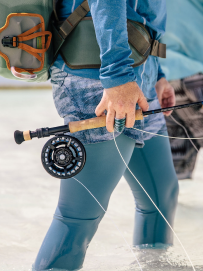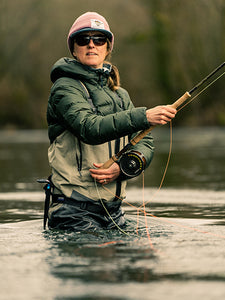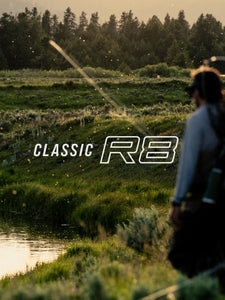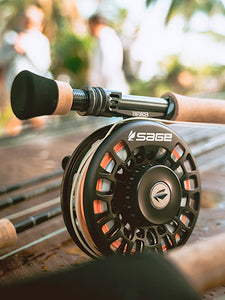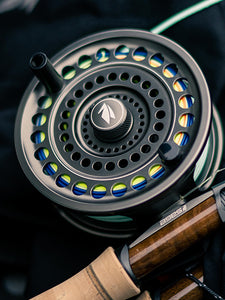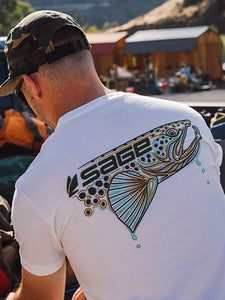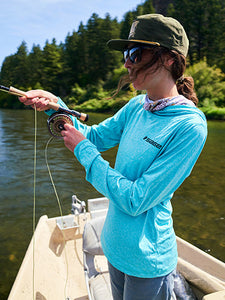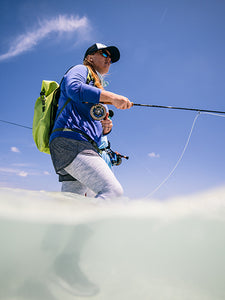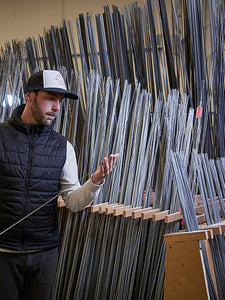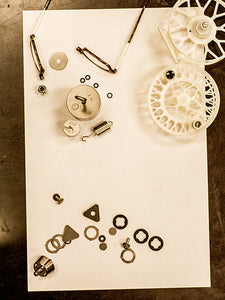
House Of The Rising Tide
It doesn’t matter what time you fell asleep, you’re still tired if you wake up at 3:00 am. It’s early – wicked early – but you have to do it. You can catch up on sleep tomorrow or next week. Or after the Striped Bass leave for winter.
Every day on the water is a story waiting to be told, but there’s more to it than what’s presented in front of you that morning. What happened yesterday, last week, last season, and even years ago can get you on the fish when it isn’t obvious where they are or what they’re doing. If you’re not out there every day yourself, the best you can do is to fish with someone else who is. They know the preamble and the prequel to the book you just started. Heck, they probably wrote it.
When it comes to the Piscataqua River, Captain Zak Robinson is the author of that book. You’ve done well if you find yourself on his boat with a fly rod in hand.
Situated roughly in the middle of the New England coastline, the Piscataqua River mouth forms the border between New Hampshire and Maine and also serves as harbor to the city of Portsmouth. From the high Interstate-95 bridge, it appears as broad, uniform, and serene. But on it, the river quickly becomes a labyrinth of strong tidal currents, shallow and deep channels, rock piles, wooded islands, sandy flats, and lobster pot buoys. Somewhere within all that, are large, native Atlantic Striped Bass – ‘Stripers’ to all of you from away.
Now in his 15th season as a licensed captain, Zak has been fishing and boating on these waters since he was a boy. Before he could enter a bar legally, he had his Coast Guard Master’s License. As a mate on charter boats during high school summers, Zak would often work all day, then fish on his own into the night only to sleep on the boat so as not to be late for the next morning’s pre-dawn trip.
Zak is also an ardent steward of the waters he fishes. He is President of the Coastal Conservation Association of New Hampshire, is an active member of the American Saltwater Guides Association, and attentively practices and promotes responsible fish handling techniques.
Zak and I have plans to meet at the launch at 5:00 am. I arrive ten minutes early but he’s already there, backing his boat down the ramp. I throw my gear bag in the hatch, lunch in the cooler, and we’re off.



Idling away from the dock, we exchange pleasantries and catch up since the last time we fished together. I can tell that Zak isn’t just chatting though, he’s multi-tasking. His eyes alternate between the horizon, gauges on his electronics, the fly that he’s knotting on, and me. I’m rambling about something forgettable when he politely cuts me off.
“Hey, sorry, but hold on a second. We’re gonna make a quick run.”
I grab my hat just in time.
As we run, I notice that Zak picks up a different fly from his box. We come off plane and he grabs the 8-weight, which is strung up with a floating line. It’s only then that I see the fish.
We spend the next 45 minutes following several pods of schoolies around, chugging gurglers through their quick blitzes. The fish come up and if we’re in range and I make the cast, we hook one. And then they’re down and we hold our cast, waiting and watching for them to start again somewhere else.
As before, Zak is doing several things at once. While keeping me in casting range of the feeding schoolies, he’s also watching terns work in the distance and checking the time. We release another feisty schoolie, but instead of a fist bump, he hands me a different rod. It’s the 9-weight, rigged with an intermediate sinking line.
“Time for a move,” he says while reeling in the topwater setup. “Let’s take a peek at what’s going on outside.”



In a few minutes I’m back on the bow, bombing casts toward the rocky shoreline. The water’s clear and I can see the white baitfish imitation pulsing and kicking as I strip-stop-strip-strip-stop in the current. Below me, seaweed sways amongst the barnacle-laden boulders.
The wind is now at my back, and it adds 15 feet to my cast. I drop one between two boat-sized rocks and start stripping.
“One’s on it,” I hear from behind me. “Keep it moving.”
I’m doing my best to maintain a consistent retrieve, but nerves are kicking in.
“There’s two. Slow it down a bit but keep it coming.”
I can see the fish now. Two wide, grey submarines cruise just a couple feet behind my fly. One of them surges ahead and I’m sure it’s about to eat. It must be six inches away from the fly and – disaster – I miss a strip and the fly stalls in the water. The fish takes one last look then peels off, giving us a full glimpse of its long, striped body.
“Oooh, that was a good one!” Zak says, laughing. “Don’t worry about it though. The sun’s getting high enough to see some fish on the flats.”



We head back into the Piscataqua and cruise upriver. My mind is stuck on a freeze-frame of the fish I just saw when Zak slows us down and we turn out of the main river. Suddenly we’re surrounded by tall pines. The wind dies, the water shallows, and we feel the warmth of the sun. Zak cuts the engine, grabs his push pole and hops onto the platform. Again, I’m holding the 8-weight with floating line but now there’s a crab pattern tied on. It seems that we’ve transported to some sort of hybrid world of the Keys and New England.
We spend the next few hours sightfishing on mud flats as Stripers follow bait with the flooding tide. Fish run the edges of deeper channels and sometimes slide across the shallows as solos or pairs. We see fish flash on the bottom, leave mud puffs, and even chase baitfish out of the water. We’re getting more refusals than takes but there are too many shots to think about the ones that didn’t eat.
It’s a rising tide, so we swap out the floating line for the intermediate and continue the game. A few more Stripers fall victim to our offerings, crashing around the shallow water when hooked. If they make it to the deep channels, we follow along behind in the skiff.
Eventually, it’s high tide and the fishing slows. We stash the intermediate rig but there’s still one more tactic to this Striped Bass triple threat – the fast sinking setup.
Back in the Piscataqua, we motor upriver more, now with a 10-weight at the ready. Zak has who-knows-how-many spots in mind and why we choose one over another, I’ll never know. He slows the boat, and I can see a current break and hard seam ahead. Attached to the front end of this 350 grain sink-tip is 20-pound test and a squid pattern longer than my hand. After one false cast, the heavy line and powerful rod send the fly right across the seam being made by an underwater boulder. We count to six and begin the retrieve; long strips with long pauses in between.



On the third cast, I come tight. I’m immediately corked, and I can feel the distinctive, slow head shakes from what I know is a big ol’ bass. Zak cuts the motor and now it’s up to me to keep this fish out of the rocks and bring it to the surface. I’m glad that I have a 10-weight to work with.
After four rounds of give and take, Zak grabs the leader and lips the bass. I step into the cockpit, lean over the gunwale, and get my hands on the mighty fish. Holding her into the current, Zak and I gaze in silence. I can tell that she’s ready, so I let go of her lip. With a single wave of her tail, we are soaked, and she returns to the depths.
By now we’ve drifted with the tide. We both hop up and look around.
“Better get ready, here comes another spot I want you to fish.”



CAPTAIN ZAK'S PERFECT SETUPS
New England Striped Bass - Floating
When making your way through most sizeable New England river-mouths during Striper season, you're just as likely to come across a group of schoolies busting bait on the surface as you are a shallow mud flat stretching out towards the main channel. Whether popping gurglers under diving terns during a blitz, or sight-casting a green crab to cruising bass in skinny water, it's essential to have a rod that can effectively handle these vastly different situations. When paired with a SPECTRUM MAX 7/8 and RIO Premier Striper WF8F line, the MAVERICK 890-4 makes a perfect setup for the surface oriented Striped Bass angler.
— Zak Robinson, Sage Ambassador
Rod: MAVERICK 890-4
Reel: SPECTRUM MAX 7/8
Line: RIO Premier Striper WF8F
NEW ENGLAND STRIPED BASS - INTERMEDIATE
It's a rising tide and the swell relentlessly assaults the barnacle-laden boulders and forests of seaweed making up the rugged New England shoreline. With every wave comes a flush of water back over the rocks and toward the sea, pulling disoriented prey with it. With their big powerful tails, Stripers use this to their advantage for an easy opportunity at a meal. This is one of the most effective ways to target large Bass on the fly, and the appropriate tools are needed to throw large wind resistant flies into the right spot, and keep the fly in the zone. Paired with a SPECTRUM MAX 9/10 and RIO Premier Striper WF9I line, the MAVERICK 990-4 makes the perfect tool for fishing the outside walls and jetty's.
— Zak Robinson, Sage Ambassador
Rod: MAVERICK 990-4
Reel: SPECTRUM MAX 9/10
Line: RIO Premier Striper WF9I
NEW ENGLAND STRIPED BASS - FAST SINK
Throughout the Northeast, it's a known fact that big tides create some of the strongest current rips in the world. Heck, they've probably got a lot to do with how Stripers have evolved into the successful predator they are over last few thousand years. They don't just survive in these conditions, they thrive, and equally as known that the largest of Stripers like to hangout in the strongest of rips. In order to effectively fish them though, you need to fish big and heavy, which is where this fast sinking rig comes into play. Paired with a SPECTRUM MAX 9/10 and RIO Premier Striper 350gr line, the SALTHD 1090-4 is the perfect powerhouse tool to effectively fish big sinking lines and big flies through the strongest of rips.
— Zak Robinson, Sage Ambassador
Rod: SALT HD 1090-4
Reel: SPECTRUM MAX 9/10
Line: RIO Premier Striper 350gr
FISH WITH CAPTAIN ZAK
Interested in putting some of this gear and these techniques to the test? Head to the link below to book your day on the water with Sage Ambassador Captain Zak Robinson.
FOLLOW ZAK ON SOCIAL MEDIA :
Words & Photography
Jesse Robbins
Editor / Writer Jesse Robbins, Sage’s Regional Sales & Community Manager, hails from Maine. After attending Bates College, where he was a member of the now infamous Bates Fishing Club, Jesse was lured west. He has spent more than a decade working for Sage and has held a number of different roles during his tenure from product development, to marketing and sales. After a decade hiatus away, he recently returned to Maine to put his acquired skills to the test in managing the sales and community for the New England territory. In addition, Jesse’s essays on ‘fishing’ have appeared in The Drake, The Flyfish Journal, Swing The Fly, and on sageflyfish.com. Outside of fly fishing, his interests include NBA playoffs, whitewater boating, and good country music.
Joe Klementovich
Photographer Look for me in the mountains, forests, rivers and oceans searching for another story to tell or image to create. I create authentic photography for editorial and commercial clients in unique and difficult locations. Photographs from assignments in the sub-zero ravines of New Hampshire's Mount Washington to the bug infested mangrove islands of the Florida Everglades fly fishing for tarpon have appeared in print nationally. I feel that my photojournalist background works well with commercial clients committed to real storytelling. My freelance career includes working with The New York Times, Boy’s Life Magazine, Fly Fisherman and many others that place a premium on capturing real people, places and the stories they tell.





